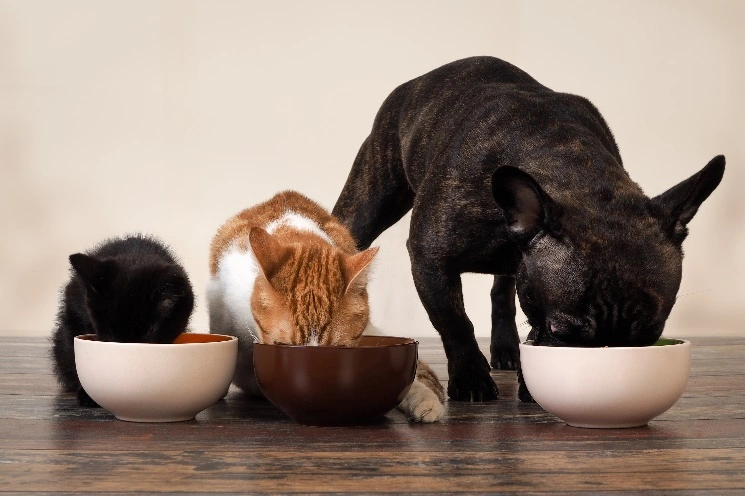
Changing your pet’s diet can be a wonderful step toward better health — but it must be done thoughtfully. Sudden switches in food, even when moving to a higher-quality formula, can cause digestive upset, diarrhea, or loss of appetite. A gentle transition allows your pet’s system to adapt to new ingredients, textures, and nutrient profiles without stress.
Whether you’re introducing a new protein source, switching from dry to wet food, or upgrading to a more natural formula, patience and balance are key to keeping mealtimes positive and stomachs happy.
Your pet’s digestive system is finely tuned to its regular diet. The enzymes, gut bacteria, and stomach acid levels adapt over time to process certain nutrients. When a new food is introduced too abruptly, this delicate balance is disrupted, leading to symptoms like:
· Soft stool or diarrhea
· Vomiting or bloating
· Loss of appetite
· Flatulence or discomfort
These reactions are usually temporary but can be stressful for both pet and parent. The good news? They’re entirely preventable with a gradual transition plan.

Most veterinarians and nutritionists recommend a 7-day gradual transition, giving your pet’s digestive system time to adjust to the new food.
Here’s a simple step-by-step approach:
Days 1–2: 75% old food + 25% new food
Days 3–4: 50% old food + 50% new food
Days 5–6: 25% old food + 75% new food
Day 7 onward: 100% new food
This slow introduction helps maintain gut microbiota balance and ensures smoother digestion. Sensitive pets — especially those with past digestive issues or food allergies — may benefit from stretching this process to 10–14 days.
During the transition, close observation is essential. Mild changes in stool consistency or frequency are normal, but watch for red flags such as:
· Persistent diarrhea or vomiting
· Lethargy or dehydration
· Refusal to eat for more than 24 hours
If symptoms persist, revert to the previous diet and consult your veterinarian. Every pet is unique — some tolerate new foods easily, while others require extra patience and dietary fine-tuning.

A successful diet change is more than just mixing foods. It’s about creating comfort and consistency. Here’s how to support your pet through the process:
1. Maintain Routine
Serve meals at the same time each day. Familiar rhythms provide comfort and help regulate digestion.
2. Hydration Is Key
Encourage your pet to drink plenty of fresh water, especially if transitioning from dry to wet food or vice versa. Proper hydration supports digestion and nutrient absorption.
3. Introduce a Digestive Aid
Consider adding probiotics or prebiotic fiber to stabilize gut flora during the transition. These can minimize bloating and improve stool quality.
4. Keep Treats Simple
Avoid introducing new treats or table scraps during this time — too many changes at once can overwhelm your pet’s digestive system.
5. Stay Positive
Use gentle encouragement and praise to make mealtime enjoyable. If your pet hesitates, try warming wet food slightly or adding a splash of low-sodium broth to enhance the aroma.
Transitioning between food textures can present unique challenges.
· Dry to Wet Food: Gradually increase the wet portion while slightly reducing dry kibble each day. This prevents overhydration or sudden texture rejection.
· Wet to Dry Food: Mix small amounts of dry kibble into wet meals, allowing your pet to adjust to the crunch and lower moisture.
· Raw Diet Transition: Introduce raw food alongside existing meals in small portions. Always handle raw products safely and ensure a balanced formulation.

At Phytopaw, we understand that inner health begins with balance. Our plant-inspired formulations — featuring soothing botanicals like aloe vera, chamomile, and witch hazel — support skin comfort and immune resilience, complementing a well-balanced diet.
A mindful dietary transition, paired with gentle, natural external care, helps pets thrive from the inside out. Together, these small choices build a foundation for lifelong vitality, comfort, and joy — one meal at a time.
References
1. National Research Council. Nutrient Requirements of Dogs and Cats. Washington (DC): The National Academies Press; 2006.
2. FEDIAF European Pet Food. Nutritional Guidelines for Complete and Complementary Pet Food for Cats and Dogs. 2024 Edition.
3. Hall EJ, German AJ. “Nutritional Management of Gastrointestinal Disease in Dogs and Cats.” Veterinary Clinics of North America: Small Animal Practice. 2020;50(6):1253–1272.
4. Panickar KS, Jewell DE. “Gut Microbiome Modulation and Digestive Health in Companion Animals.” Animals (Basel). 2023;13(8):1320.